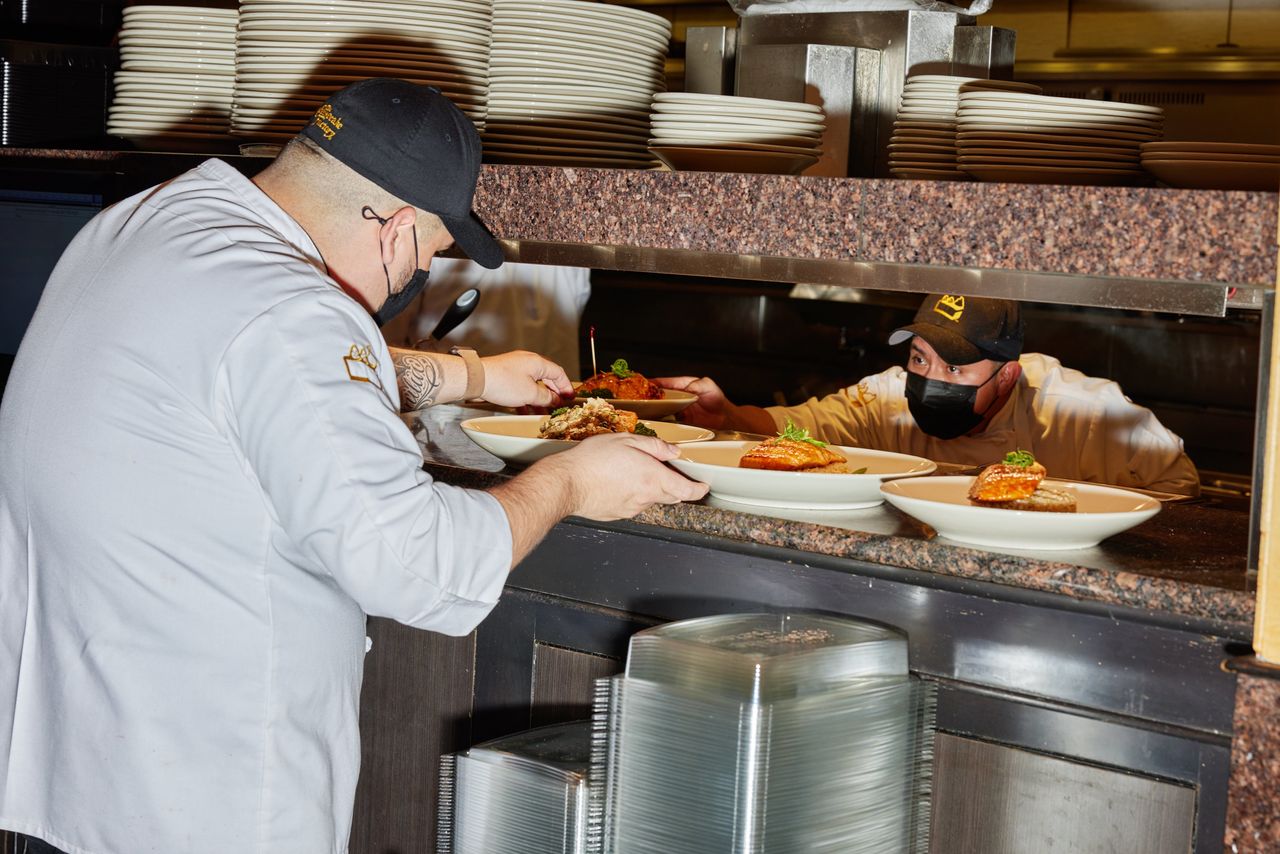A Table Outside? More Diners Say No Way
Restaurants say heat waves, smoke have hurt their outdoor dining business
Stretches of severely high temperatures across the U.S. are taking a toll on restaurants.
Customers are avoiding patios during heat waves, cutting into a key source of summertime sales for many restaurants, owners said. Visits in July and August declined from earlier in the year, industry data showed, with chains including Chuy’s and Cheesecake Factory reporting a decline in outdoor business this summer.
“No one’s sitting out in the patio at 100 degrees,” Steve Hislop, chief executive of Texas-based Chuy’s, said during an Aug. 3 earnings call.
Utility expenses are also rising as restaurants run air conditioning at full blast for long stretches of time, operators and industry groups said.
Temperatures climbing to the highest levels in recorded history this summer have hurt hospitality, sports, agriculture and many other businesses. In states such as Texas, weeks of days topping 100 degrees are expected to reduce overall economic productivity.
Restaurants are contending with heat and smoke as many operators are fighting for sales from cash-strapped consumers, and dealing with high inflation in food, labour and other costs.
Diners overall at restaurants in Arizona, Florida and Georgia dropped between 6% and 8% in the first part of August compared with last year’s period, according to OpenTable. The reservation tech company also recorded diner declines in other states running hot this summer, including Texas and North Carolina.
“This summer does feel different,” said Kelsey Erickson Streufert, chief public affairs officer for the Texas Restaurant Association trade group. “It’s a little tougher to get people to come out.”
Employees working at restaurants and bars dipped 1.5% in July compared with the month prior, with steep declines in cities such as San Antonio, New Orleans and Phoenix that recorded high temperatures during the month, according to Homebase, a small business workforce app. The declines likely stemmed from extreme temperatures disrupting consumer spending and foot traffic, Homebase said.
Worker advocates are increasingly making heat an issue in campaigns for improved conditions for restaurant workers. Some are pushing for better enforcement of existing standards and additional federal indoor heat regulations to provide employees breaks and water when temperatures rise.
“We’ve seen 86 degrees on the coolest side of the kitchen,” said Ariana Lingerfeldt, a cook at an Asheville, N.C., restaurant who is a member of the Restaurant Opportunities Centers United worker advocacy group, during an Aug. 9 event pushing for more heat standards. “The air conditioner is unable to keep up with the equipment.”
Some restaurant operators said they are giving their workers more water and rest breaks, since kitchen temperatures can climb steeply despite air-conditioning.
Many restaurants set up patios in the early days of the Covid-19 pandemic, and have come to rely on them to drive summer sales. New York City, for example, is poised to make expanded outdoor dining in roadways permanent from April to November, and supporters say patios have helped restaurants maintain sales and jobs.
Now, some restaurant owners said those patio sales are drying up when temperatures surge, or wildfire smoke blows.
“When the sun’s on it, it’s literally scalding out there,” said Marc Hochmuth, general manager of City Social restaurant in downtown Chicago, which has a patio. Hochmuth said his business dropped about 20% overall when temperatures soared this summer.
Zoe Dean-Neil, a 20-year-old Pennsylvania resident who was on vacation in Chicago in August, said she opted to eat inside in the air conditioning after a day walking around in the heat. “I don’t want to sit outside and sweat,” she said.
Smoke drifting into the U.S. from Canadian wildfires also affected business at restaurants in parts of the country earlier this summer. John DuBuque, a 31-year-old management consultant from Chicago, said he tried to have a glass of wine outside during one heavily smoky period in the city, and regretted it.
“It was not the vibe,” said DuBuque, who said he now makes more outdoor dining decisions based on the air quality index.
Restaurant owners are trying to work around the weather. Sue Rigler, owner of Hundred Mile Brewing Company in Tempe, Ariz., said she is misting and putting extra fans on her outside beer chilling units to keep them cool. She has also cut back on labor in response to slower sales that she attributes to the heat.
“July was a really hard month,” Rigler said. “We finally got a break at 108, and they call that a break.”
Tom Hutchinson, owner of La Posta de Mesilla and Hacienda de Mesilla in New Mexico, said his hotel and restaurants are promoting cold beers and margaritas to attract customers. He is also hoping to keep people coming to the outdoor space surrounding their adobe building at night when temperatures may fall to the 90s.
“We don’t have humidity in our state and you can tolerate that,” he said.
Longer term, restaurant operators are trying to adjust to more climate-driven variables.
Avram Hornik, owner of the FCM Hospitality group of restaurants, bars and outdoor pop-up venues in Philadelphia, said his sales are down 30% this summer because of weeks of heat and rain. Smoky conditions in June didn’t help, he said.
“I look at it such as being a farmer. The weather controls all,” he said.
 Copyright 2020, Dow Jones & Company, Inc. All Rights Reserved Worldwide. LEARN MORE
Copyright 2020, Dow Jones & Company, Inc. All Rights Reserved Worldwide. LEARN MORE
This stylish family home combines a classic palette and finishes with a flexible floorplan
Just 55 minutes from Sydney, make this your creative getaway located in the majestic Hawkesbury region.
Continued stagflation and cost of living pressures are causing couples to think twice about starting a family, new data has revealed, with long term impacts expected
Australia is in the midst of a ‘baby recession’ with preliminary estimates showing the number of births in 2023 fell by more than four percent to the lowest level since 2006, according to KPMG. The consultancy firm says this reflects the impact of cost-of-living pressures on the feasibility of younger Australians starting a family.
KPMG estimates that 289,100 babies were born in 2023. This compares to 300,684 babies in 2022 and 309,996 in 2021, according to the Australian Bureau of Statistics (ABS). KPMG urban economist Terry Rawnsley said weak economic growth often leads to a reduced number of births. In 2023, ABS data shows gross domestic product (GDP) fell to 1.5 percent. Despite the population growing by 2.5 percent in 2023, GDP on a per capita basis went into negative territory, down one percent over the 12 months.
“Birth rates provide insight into long-term population growth as well as the current confidence of Australian families,” said Mr Rawnsley. “We haven’t seen such a sharp drop in births in Australia since the period of economic stagflation in the 1970s, which coincided with the initial widespread adoption of the contraceptive pill.”
Mr Rawnsley said many Australian couples delayed starting a family while the pandemic played out in 2020. The number of births fell from 305,832 in 2019 to 294,369 in 2020. Then in 2021, strong employment and vast amounts of stimulus money, along with high household savings due to lockdowns, gave couples better financial means to have a baby. This led to a rebound in births.
However, the re-opening of the global economy in 2022 led to soaring inflation. By the start of 2023, the Australian consumer price index (CPI) had risen to its highest level since 1990 at 7.8 percent per annum. By that stage, the Reserve Bank had already commenced an aggressive rate-hiking strategy to fight inflation and had raised the cash rate every month between May and December 2022.
Five more rate hikes during 2023 put further pressure on couples with mortgages and put the brakes on family formation. “This combination of the pandemic and rapid economic changes explains the spike and subsequent sharp decline in birth rates we have observed over the past four years,” Mr Rawnsley said.
The impact of high costs of living on couples’ decision to have a baby is highlighted in births data for the capital cities. KPMG estimates there were 60,860 births in Sydney in 2023, down 8.6 percent from 2019. There were 56,270 births in Melbourne, down 7.3 percent. In Perth, there were 25,020 births, down 6 percent, while in Brisbane there were 30,250 births, down 4.3 percent. Canberra was the only capital city where there was no fall in the number of births in 2023 compared to 2019.
“CPI growth in Canberra has been slightly subdued compared to that in other major cities, and the economic outlook has remained strong,” Mr Rawnsley said. “This means families have not been hurting as much as those in other capital cities, and in turn, we’ve seen a stabilisation of births in the ACT.”
This stylish family home combines a classic palette and finishes with a flexible floorplan
Just 55 minutes from Sydney, make this your creative getaway located in the majestic Hawkesbury region.





















